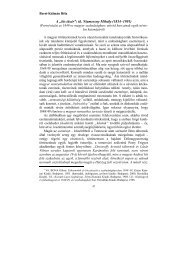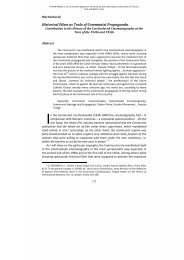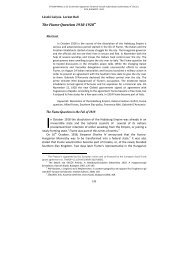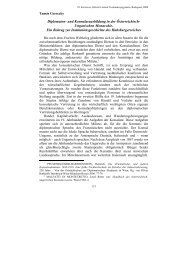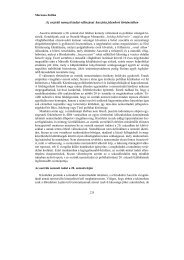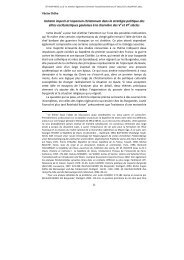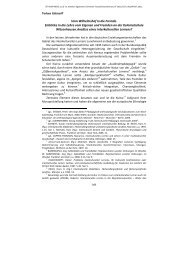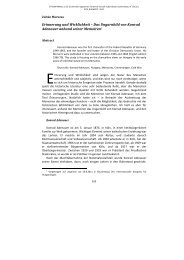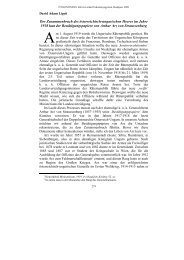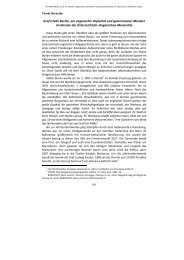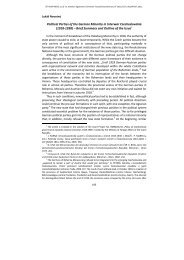The Molotov-Ribbentrop Pact - ELTE BTK Történelem Szakos Portál
The Molotov-Ribbentrop Pact - ELTE BTK Történelem Szakos Portál
The Molotov-Ribbentrop Pact - ELTE BTK Történelem Szakos Portál
Create successful ePaper yourself
Turn your PDF publications into a flip-book with our unique Google optimized e-Paper software.
Hungary sought to set up a common border and additionally Polish government<br />
remonstrated with the recruiting Ukrainian nationalist politicians prosecuted in<br />
Poland in Carpatho-Ukraine administration. 16<br />
2. Secondly, at least since the death of Yevhen Konovalets in March 1938<br />
there was a deep division within Organization of Ukrainian Nationalists<br />
(OUN), the main independence movement in Ukraine. <strong>The</strong>refore, some<br />
politicians expressed their skepticism about special role of Carpatho-Ukraine,<br />
while others, the young ones, joined the Carpathian Sich en masse.<br />
3. And thirdly – the most important thing – the German view. It was<br />
Hitler who approved Hungarian annexation of Carpatho-Ukraine. What did<br />
happen with the project of „Great Ukraine” 17 ? Faced with two rival plans,<br />
Hungarian and Ukrainian, Hitler’s approach was to say yes to the stronger one.<br />
Hungary, at least since the time that Bela Imredy was appointed prime minister,<br />
has belonged to the closest allies of Germany. Thus far they had consented to<br />
German economic penetration and – what probably was decisive – on 24 th<br />
February 1939, a month before an invasion, they joined the Anti-Comintern<br />
<strong>Pact</strong>. Moreover, it’s pointless to pretend that Hitler or anybody from his tight<br />
inner circle was a slavophile; as a matter of fact day after crash of Carpatho-<br />
Ukraine Hitler intimated president of Czechoslovakia Emil Hacha into<br />
accepting the German occupation of the Czech rump state. Yet in this case, the<br />
idea of „Great Ukraine” – and <strong>Ribbentrop</strong> must have known it – was<br />
exaggerated and inconceivably in winter 1938/1939. Questions of Galicia,<br />
Volhynia and the Soviet part of Ukraine must have been left unanswered,<br />
because plans of any territorial changes of Poland and – notably – the Soviet<br />
Union at that moment would go too far.<br />
What were the consequences for German-Ukrainian relations of failure of<br />
Carpatho-Ukraine? Although the episode served as a graphic illustration of<br />
how little Ukrainians could depend on the goodwill of Hitler, he was<br />
continuously reported to be deliverance by many politicians in Ukraine. It was<br />
Hungary and Poland that in their opinion bore all the blame for the decline of<br />
Carpatho-Ukraine. In April 1939 Andrij Melnyk, a leader of the OUN,<br />
16 PAGEL, J.: Polska i Związek Radziecki w czasie kryzysu czechosłowackiego<br />
(marzec-październik 1938). In: SIERPOWSKI, Stanisław (ed.): Niemcy w polityce<br />
międzynarodowej 1919-1939. Tom III- W dobie Monachium. Poznań, 1992. 343. Hungary<br />
was also afraid of the Ukrainian nationalist politicians, see more: MARUZSA, Zoltán: A<br />
meg nem valósult területi gyarapodás. Német-magyar diplomáciai tárgyalások<br />
Magyarország terjeszkedéséről a Keleti-Kárpátokon túl 1941-42 folyamán. 403-415. pp.<br />
In: Eszmék, forradalmak, háborúk. Vadász Sándor 80 éves. Szerk.: Háda Béla, Ligeti<br />
Dávid, Majoros István, Maruzsa Zoltán, Merényi Krisztina, Petneházi Margit. <strong>ELTE</strong> <strong>BTK</strong><br />
Új- és Jelenkori Egyetemes Történeti Tanszék, Budapest, 2010.<br />
17 It’s worth mentioning that project of „Great Ukraine” was not openly supported by<br />
authorities of Carpatho-Ukraine. On the contrary, Voloshyn stressed that his main aim is to<br />
maintain good relations with neighbouring countries and he rather opted for „organic work”<br />
within Carpatho-Ukraine. GRELKA, Frank: Polityka III Rzeszy wobec ukraińskich zmagań<br />
niepodległościowych w latach 1934-1941. In: Biuletyn Ukrainoznawczy, 12/2006. 66.<br />
107



